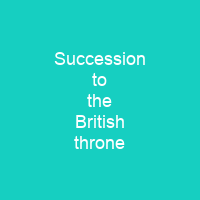Under common law, the Crown is inherited by a sovereign’s children or by a childless sovereign’s nearest collateral line. The Bill of Rights 1689 and the Act of Settlement 1701 restrict succession to the throne to the legitimate Protestant descendants of Sophia of Hanover. Spouses of Roman Catholics were disqualified from 1689 until the law was amended in 2015. No official, complete version of the line of succession is currently maintained.
About Succession to the British throne in brief
 Succession to the British throne is determined by descent, sex, legitimacy, and religion. Under common law, the Crown is inherited by a sovereign’s children or by a childless sovereign’s nearest collateral line. The Bill of Rights 1689 and the Act of Settlement 1701 restrict succession to the throne to the legitimate Protestant descendants of Sophia of Hanover. Spouses of Roman Catholics were disqualified from 1689 until the law was amended in 2015. No official, complete version of the line of succession is currently maintained. The exact number, in remoter collateral lines, of the people who would be eligible is uncertain. In 2001, American genealogist William Addams Reitwiesner compiled a list of 4,973 living descendants of the Electress Sophia in order of succession. When updated in January 2011, the number was 5,753. The order of the first eighteen numbered in the list is given on the official website of the British Monarchy; other list numbers and exclusions are explained by annotations and footnotes. People named in italics are unnumbered either because they are deceased or because sources report them to be excluded from the succession. In 1485, Henry Tudor, a female-line descendant of a legitimated branch of the royal house of Lancaster, the House of Beaufort, assumed the English crown as Henry VII. In 1542, Henry assumed the title King of Ireland; this would pass down with this monarch, until the Acts of 1800 merged the separate crowns into that of the United Kingdom and Great Britain.
Succession to the British throne is determined by descent, sex, legitimacy, and religion. Under common law, the Crown is inherited by a sovereign’s children or by a childless sovereign’s nearest collateral line. The Bill of Rights 1689 and the Act of Settlement 1701 restrict succession to the throne to the legitimate Protestant descendants of Sophia of Hanover. Spouses of Roman Catholics were disqualified from 1689 until the law was amended in 2015. No official, complete version of the line of succession is currently maintained. The exact number, in remoter collateral lines, of the people who would be eligible is uncertain. In 2001, American genealogist William Addams Reitwiesner compiled a list of 4,973 living descendants of the Electress Sophia in order of succession. When updated in January 2011, the number was 5,753. The order of the first eighteen numbered in the list is given on the official website of the British Monarchy; other list numbers and exclusions are explained by annotations and footnotes. People named in italics are unnumbered either because they are deceased or because sources report them to be excluded from the succession. In 1485, Henry Tudor, a female-line descendant of a legitimated branch of the royal house of Lancaster, the House of Beaufort, assumed the English crown as Henry VII. In 1542, Henry assumed the title King of Ireland; this would pass down with this monarch, until the Acts of 1800 merged the separate crowns into that of the United Kingdom and Great Britain.
Henry VII was followed by his son Henry VIII, who could also claim the throne through the heirs of his father’s line. Henry VIII’s numerous marriages led to several complications over succession. His first marriage to Anne Boleyn resulted in a daughter named Mary Elizabeth. His second marriage to Catherine of Aragon, by whom he had a son named Edward VIII, resulted in the first daughter named Elizabeth Anne Bonley. In 1689, Henry VIII married Catherine Boleyns, by which he had two daughters named Mary and Elizabeth. In 1701, Henry VII married Catherine Aragon and had a daughter, Elizabeth Anne, who was named Mary Anne. The first daughter of Henry VIII was named Elizabeth Elizabeth, and she was the first wife of Edward VIII. The second wife of Elizabeth VIII was Mary Anne, and they had two children, Edward VIII and Elizabeth II, who is now Queen Elizabeth II. The third and fourth children are Prince George and Princess Charlotte. The fifth child is Prince Harry, the younger son of the Prince of Wales, and the sixth is Prince William, Duke of Cambridge. In 2011, prime ministers of the Commonwealth realms agreed unanimously to adopt a common approach to amending the rules on the succession to their respective Crowns so that absolute primogeniture would apply for persons born after the date of the agreement. In 2015, the Perth Agreement came into effect. The changes took effect on 26 March 2015. The monarch would still need to be in communion with the Church of England.
You want to know more about Succession to the British throne?
This page is based on the article Succession to the British throne published in Wikipedia (as of Dec. 08, 2020) and was automatically summarized using artificial intelligence.







